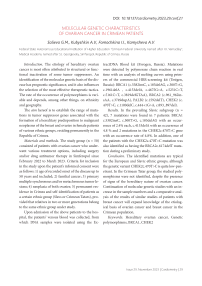Molecular genetic characteristics of ovarian cancer in Crimean patients
Автор: Salieva G.M., Kubyshkin A.V., Fomochkina I.I., Kamysheva A.V.
Журнал: Cardiometry @cardiometry
Рубрика: Conference proceedings
Статья в выпуске: 29, 2023 года.
Бесплатный доступ
The etiology of hereditary ovarian cancer is most often attributed to structural or functional inactivation of some tumor suppressors. An identification of the molecular genetic basis of the disease has prognostic significance, and it also influences the selection of the most effective therapeutic tactics. The rate of the occurrence of polymorphisms is variable and depends, among other things, on ethnicity and geography.
Hereditary ovarian cancer, genetic, polymorphisms, brca1, chek2
Короткий адрес: https://sciup.org/148327393
IDR: 148327393 | DOI: 10.18137/cardiometry.2023.29.conf.21
Текст статьи Molecular genetic characteristics of ovarian cancer in Crimean patients
The aim hereof is to establish the range of mutations in tumor suppressor genes associated with the formation of a hereditary predisposition to malignant neoplasms of the breast and ovaries in female patients of various ethnic groups, residing permanently in the Republic of Crimea.
Materials and methods . The study group (n = 50) consisted of patients with ovarian cancer who underwent various treatment options, including surgery and/or drug antitumor therapy in Simferopol since February 2022 to March 2023. Criteria for inclusion in the study upon the patient’s informed consent were as follows: 1) age of recorded onset of the disease up to 50 years and included; 2) familial cancer; 3) primary multiple synchronous and/or metachronous tumor lesions; 4) neoplasia of both ovaries; 5) permanent residence in Crimea and self-identification of patients as a certain ethnic group (Slavs or Crimean Tatars), provided that relatives in two or more generations belong to the same ethnic group under study.
Upon admission of the above patients to the hospital, the patients’ venous blood was collected, from which DNA samples were isolated using the Ex- tractDNA Blood kit (Evrogen, Russia). Mutations were detected by polymerase chain reaction in real time with an analysis of melting curves using primers of the commercial HRR-screening kit (Testgen, Russia): BRCA1 (c.5382insC, c.185delAG, c.300T>G, c.1961delA , c.4153delA, c.4675G>A, c.5251C>T, c.5161C>T, c.3819delGTAA), BRCA2 (c.961_962in-sAA, c.3749dupA), PALB2 (c.1592delT), CHEK2 (c. 470T>C, c.1100delC, c.444+1G>A, c.893_897del).
Results . In the prevailing Slavic subgroup (n = 42), 7 mutations were found in 7 patients: BRCA1 c.5382insC, c.300T>G, c.185delAG with an occurrence of 2.4% each, c.4153delA with an occurrence of 4.8 % and 2 mutations in the CHEK2c.470T>C gene with an occurrence rate of 4.8%. In addition, one of the patients with the CHEK2c.470T>C mutation was also identified as having the BRCA2c.6174delT mutation during a preliminary study.
Conclusion . The identified mutations are typical for the European and Slavic ethnic groups, although the genetic variant CHEK2c.470T>C is quite low-penetrant. In the Crimean Tatar group, the studied polymorphisms were not identified, despite the presence of signs of the hereditary nature of ovarian cancer. Continuation of molecular genetic studies with an increase in the sample numbers and a comparative analysis of the results of similar studies of patients with breast cancer will expand knowledge of the etiological basis of ovarian cancer and breast cancer in the Crimean population.


